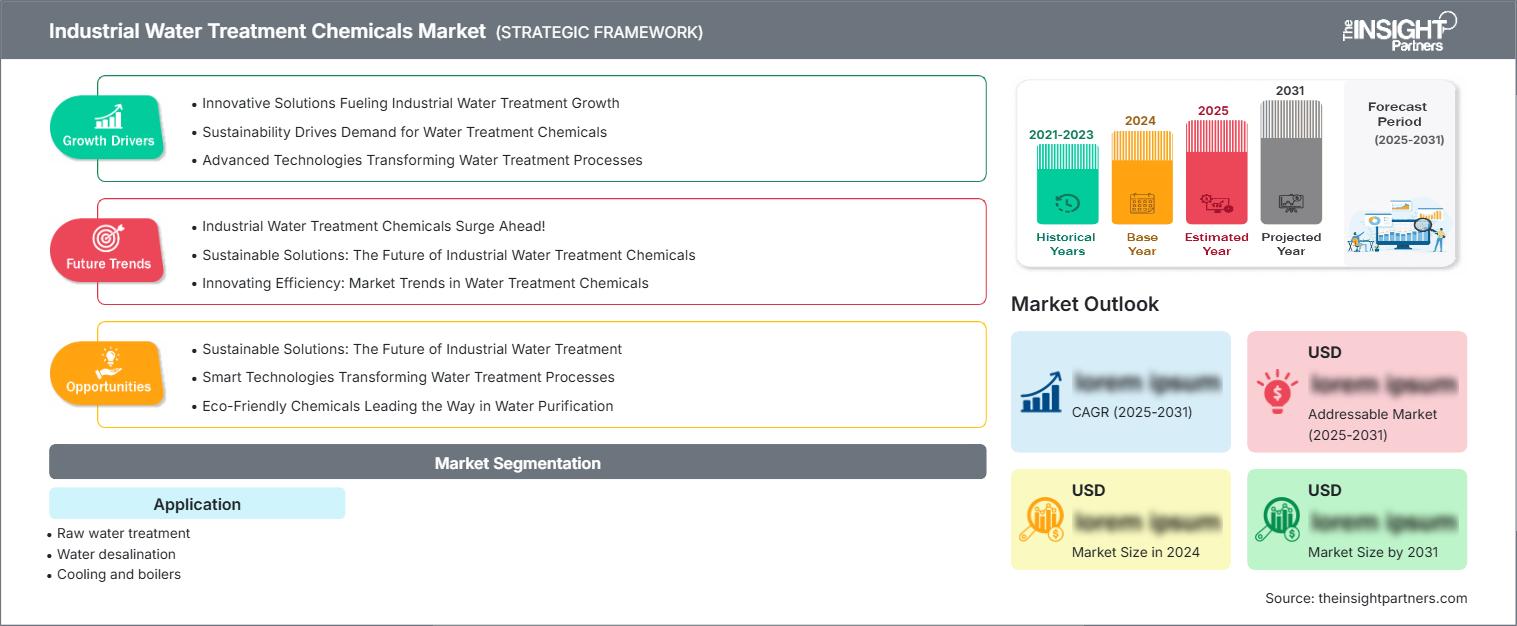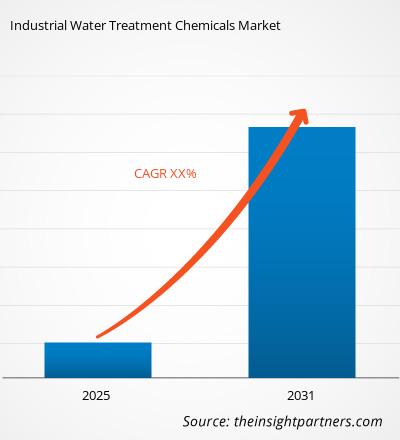PANORAMA DEL MERCADO
El tratamiento de aguas industriales es esencial para optimizar diversos procesos industriales que utilizan agua, como el calentamiento, la refrigeración, el enjuague, el procesamiento y la limpieza. La formación de incrustaciones, la actividad microbiológica, la corrosión y la eliminación de aguas residuales son los cuatro principales problemas en cualquier industria. El agua cruda o sin tratar debe tratarse antes de su uso en las industrias para cumplir con los estándares de calidad y las especificaciones del proceso. El tratamiento de aguas en las industrias garantiza el buen funcionamiento de los procesos industriales y la reducción de los costes operativos.
El "Análisis del Mercado Global de Productos Químicos para el Tratamiento de Aguas Industriales hasta 2031" es un estudio especializado y exhaustivo de la industria química y de materiales, con especial atención al análisis de las tendencias del mercado global. El informe busca ofrecer una visión general del mercado de productos químicos para el tratamiento de aguas industriales, con una segmentación detallada por aplicación y geografía. El informe proporciona estadísticas clave sobre la situación de los principales actores del mercado de productos químicos para el tratamiento de aguas industriales y presenta las principales tendencias y oportunidades del mercado.
Obtendrá personalización en cualquier informe, sin cargo, incluidas partes de este informe o análisis a nivel de país, paquete de datos de Excel, así como también grandes ofertas y descuentos para empresas emergentes y universidades.
Mercado de productos químicos para el tratamiento de aguas industriales: Perspectivas estratégicas

-
Obtenga las principales tendencias clave del mercado de este informe.Esta muestra GRATUITA incluirá análisis de datos, desde tendencias del mercado hasta estimaciones y pronósticos.
SEGMENTACIÓN DEL MERCADO
- Según la aplicación, el mercado global de productos químicos para el tratamiento de agua industrial está segmentado en tratamiento de agua cruda, desalinización de agua, refrigeración y calderas, tratamiento de aguas efluentes y otros.
Perspectivas regionales del mercado de productos químicos para el tratamiento de aguas industriales
Los analistas de The Insight Partners han explicado detalladamente las tendencias regionales y los factores que influyen en el mercado de productos químicos para el tratamiento de aguas industriales durante el período de pronóstico. Esta sección también analiza los segmentos y la geografía del mercado de productos químicos para el tratamiento de aguas industriales en América del Norte, Europa, Asia Pacífico, Oriente Medio y África, y América del Sur y Central.
Alcance del informe de mercado de productos químicos para el tratamiento de aguas industriales
| Atributo del informe | Detalles |
|---|---|
| Tamaño del mercado en 2024 | US$ XX millones |
| Tamaño del mercado en 2031 | US$ XX millones |
| CAGR global (2025-2031) | XX% |
| Datos históricos | 2021-2023 |
| Período de pronóstico | 2025-2031 |
| Segmentos cubiertos |
Por aplicación
|
| Regiones y países cubiertos |
América del norte
|
| Líderes del mercado y perfiles de empresas clave |
|
Densidad de actores del mercado de productos químicos para el tratamiento de aguas industriales: comprensión de su impacto en la dinámica empresarial
El mercado de productos químicos para el tratamiento industrial de aguas está creciendo rápidamente, impulsado por la creciente demanda de los usuarios finales debido a factores como la evolución de las preferencias de los consumidores, los avances tecnológicos y un mayor conocimiento de los beneficios del producto. A medida que aumenta la demanda, las empresas amplían su oferta, innovan para satisfacer las necesidades de los consumidores y aprovechan las tendencias emergentes, lo que impulsa aún más el crecimiento del mercado.

- Obtenga una descripción general de los principales actores clave del mercado de productos químicos para el tratamiento de agua industrial
DINÁMICA DEL MERCADO
Conductores
- Creciente demanda de tratamiento de aguas residuales industriales junto con apoyo regulatorio para el tratamiento del agua.
- Las economías emergentes ofrecen importantes oportunidades de crecimiento para los actores del mercado con una rápida industrialización.
- Creciente necesidad de agua potable.
- Las crecientes actividades de I+D impulsan el mercado de productos químicos para el tratamiento de aguas industriales.
Restricciones
- Alto costo asociado a los sistemas de tratamiento de agua y su mantenimiento.
MARCO REGIONAL
El informe ofrece una visión general detallada de la industria, con información tanto cualitativa como cuantitativa. Ofrece una visión general y un pronóstico del mercado global basado en diversos segmentos. También proporciona el tamaño del mercado y estimaciones de pronóstico para el período 2021-2031 en cinco regiones principales: América del Norte, Europa, Asia-Pacífico (APAC), Oriente Medio y África (MEA) y América del Sur. El mercado de productos químicos para el tratamiento de aguas industriales por región se subdivide posteriormente en los respectivos países y segmentos. El informe abarca el análisis y el pronóstico de 18 países a nivel mundial, junto con las tendencias actuales y las oportunidades que prevalecen en la región.
El informe analiza los factores que afectan al mercado, tanto desde el punto de vista de la demanda como de la oferta, y evalúa la dinámica del mercado durante el período de pronóstico, es decir, los factores impulsores, las limitaciones, las oportunidades y las tendencias futuras. El informe también proporciona un análisis PEST exhaustivo para las cinco regiones: Norteamérica, Europa, Asia-Pacífico, Oriente Medio y África (MEA) y Sudamérica, tras evaluar los factores políticos, económicos, sociales y tecnológicos que afectan al mercado de productos químicos para el tratamiento industrial del agua en estas regiones.
IMPACTO DE LA COVID-19 EN EL MERCADO DE PRODUCTOS QUÍMICOS PARA EL TRATAMIENTO DE AGUA INDUSTRIAL
La COVID-19 comenzó en Wuhan (China) en diciembre de 2019 y, desde entonces, se ha propagado rápidamente por todo el mundo. Estados Unidos, India, Brasil, Rusia, Francia, Reino Unido, Turquía, Italia y España se encuentran entre los países más afectados en cuanto a casos confirmados y fallecimientos. La industria química y de materiales es una de las principales que sufre graves interrupciones, como interrupciones en la cadena de suministro, cancelaciones de eventos tecnológicos y cierres de oficinas, como consecuencia de esta pandemia. El cierre de diversas plantas y fábricas en regiones clave como Norteamérica, Europa, Asia Pacífico, Sudamérica, Oriente Medio y África ha afectado a la cadena de suministro global y ha afectado negativamente a la fabricación, los plazos de entrega y las ventas de diversos productos. Además, varias empresas ya han anunciado posibles retrasos en las entregas de productos y una caída en las ventas futuras. El mercado del metal impreso en 3D se ha visto afectado por la pandemia debido al déficit de producción y a la paralización de los proyectos de construcción debido al confinamiento global.
AGENTES DEL MERCADO
El informe abarca los principales avances en el mercado de productos químicos para el tratamiento de aguas industriales, como estrategias de crecimiento orgánico e inorgánico. Diversas empresas se centran en estrategias de crecimiento orgánico, como lanzamientos y aprobaciones de productos, y otras como patentes y eventos. Las estrategias de crecimiento inorgánico observadas en el mercado incluyen adquisiciones, alianzas y colaboraciones. Estas actividades han facilitado la expansión del negocio y la cartera de clientes de los actores del mercado. Se prevé que los participantes del mercado de productos químicos para el tratamiento de aguas industriales tengan oportunidades de crecimiento lucrativas en el futuro, dada la creciente demanda de productos químicos para el tratamiento de aguas industriales en el mercado global.
El informe también incluye los perfiles de empresas clave, junto con su análisis FODA y estrategias de mercado en el mercado de productos químicos para el tratamiento de aguas industriales. Además, se centra en los principales actores del sector, con información como perfiles de empresas, componentes y servicios ofrecidos, información financiera de los últimos tres años y los principales avances de los últimos cinco años.
- Akzo Nobel NV
- BASF SE
- Laboratorios Buckman Internacional, Inc.
- Corporación Cortec
- Ecolab Inc.
- Kemira Oyj
- Solenis LLC
- Solvay SA
- Suez SA
- La compañía química Dow
El equipo dedicado de investigación y análisis de Insight Partner está formado por profesionales experimentados con conocimientos estadísticos avanzados y ofrece varias opciones de personalización en el estudio existente.
- Análisis histórico (2 años), año base, pronóstico (7 años) con CAGR
- Análisis PEST y FODA
- Tamaño del mercado, valor/volumen: global, regional y nacional
- Industria y panorama competitivo
- Conjunto de datos de Excel
Informes recientes
Testimonios
Razón para comprar
- Toma de decisiones informada
- Comprensión de la dinámica del mercado
- Análisis competitivo
- Información sobre clientes
- Pronósticos del mercado
- Mitigación de riesgos
- Planificación estratégica
- Justificación de la inversión
- Identificación de mercados emergentes
- Mejora de las estrategias de marketing
- Impulso de la eficiencia operativa
- Alineación con las tendencias regulatorias






















 Obtenga una muestra gratuita para - Mercado de productos químicos para el tratamiento de aguas industriales
Obtenga una muestra gratuita para - Mercado de productos químicos para el tratamiento de aguas industriales